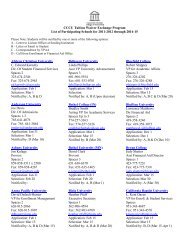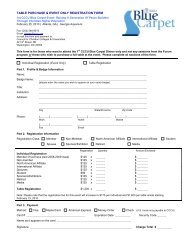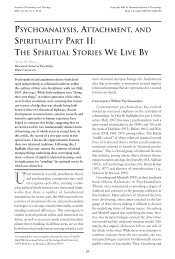Download Presentation - Council for Christian Colleges & Universities
Download Presentation - Council for Christian Colleges & Universities
Download Presentation - Council for Christian Colleges & Universities
Create successful ePaper yourself
Turn your PDF publications into a flip-book with our unique Google optimized e-Paper software.
<strong>Council</strong> <strong>for</strong> <strong>Christian</strong> <strong>Colleges</strong> & <strong>Universities</strong><br />
Financial Aid in the New Normal<br />
Mary Piccioli<br />
December 2, 2011<br />
Guided by data, driven by service
Guided by data, driven by service<br />
Overview<br />
• The Changing Environment<br />
• 12 Elements of an Effective Aid Strategy<br />
• Conclusion<br />
2
Guided by data, driven by service<br />
The Changing Environment<br />
• During the fall 2010 recruitment cycle and<br />
again this year, a number of trends have<br />
emerged or accelerated:<br />
• Students are applying to more schools.<br />
• The number of students applying <strong>for</strong> aid has<br />
increased.<br />
• Attending a community college <strong>for</strong> the first<br />
two years has become more socially and<br />
educationally acceptable; in some cases it’s<br />
an economic imperative.<br />
3
Guided by data, driven by service<br />
The Changing Environment<br />
• Families believe it is most appropriate to appeal<br />
their first aid offer.<br />
• Many state aid programs are being reduced or<br />
eliminated.<br />
• Many institutions experienced “late-breaking”<br />
deposits, right up to and after May 1 st .<br />
• Significant additions/changes in Title IV<br />
regulatory requirements, particularly in<br />
consumer in<strong>for</strong>mation and program integrity.<br />
4
Guided by data, driven by service<br />
The Changing Environment<br />
• Many small institutions saw their discount<br />
rates increase without corresponding<br />
increases in enrollment.<br />
• Increased need<br />
• Reduction in state grant programs<br />
• Reaction to competitor financial aid strategies<br />
5
Guided by data, driven by service<br />
Average Tuition Discounting Rates:<br />
First-time, Full-Time Freshmen<br />
Institution Type<br />
Number of<br />
Respondents 2000 2005 2006 2007 2008 2009 2010*<br />
Compr/Doctoral 49 33.2% 31.8% 33.8% 34.3% 37.4% 36.1% 36.6%<br />
Research 29 32.0% 34.9% 33.7% 33.8% 37.4% 38.9% 38.7%<br />
Small Institutions 303 39.0% 39.3% 40.2% 40.7% 40.5% 42.8% 43.7%<br />
Total 381 37.3% 38.0% 38.8% 39.3% 39.9% 41.6% 42.4%<br />
*Preliminary Estimate<br />
Source: 2010 NACUBO Tuition Discounting Survey<br />
6
Guided by data, driven by service<br />
The Changing Environment<br />
• Institutions are struggling to understand how to adjust<br />
their aid policies to meet the “new normal.”<br />
• Some are responding much more generously to appeals.<br />
• Others are abandoning expensive policies:<br />
• Elimination of merit aid (Hamilton)<br />
• Need-blind admission (Reed)<br />
• No or reduced loan policies (Williams, Dartmouth)<br />
• Others are strengthening their value and outcomes messages<br />
or reducing time to degree (but those can’t usually happen<br />
overnight).<br />
• And some are even lowering price. (Sewanee, Univ. of<br />
Charleston, Cabrini College)<br />
7
Guided by data, driven by service<br />
The Changing Environment<br />
• How is the way your families are paying <strong>for</strong> college<br />
changing?<br />
• Family contributions<br />
• Federal grants<br />
• State grants<br />
• Need-based loans<br />
• Student work<br />
• Alternative loans<br />
• Payment plans<br />
8
Guided by data, driven by service<br />
Sample Comparison Chart<br />
Fall of: 2008 2010<br />
Family contributions/private loans $5,255 $6,030<br />
Federal grants $1,179 $2,074<br />
State grants $2,103 $1,558<br />
Institutional grant $9,739 $10,066<br />
Need-based loans $2,294 $2,562<br />
Student work $1,350 $1,650<br />
Tuition & Fees $21,920 $23,940<br />
9
Guided by data, driven by service<br />
The Changing Environment<br />
• As you discuss your institution’s response to<br />
the “new normal,” here are twelve critical<br />
elements to keep in mind.<br />
10
Guided by data, driven by service<br />
Element #1:<br />
The New Transparency<br />
• Guaranteed Merit Awards<br />
• Entitlements<br />
• How schools are dealing with the net price<br />
calculator<br />
11
Guided by data, driven by service<br />
Element #2:<br />
Watch out <strong>for</strong> “Stacking”<br />
• One downside of being transparent<br />
• Often largest awards (number and dollars) go to those<br />
with a natural connection to the institution<br />
• Timing is important<br />
• Be sure to capitalize on federal/state grants in your<br />
packaging policies<br />
• Micro-target programs are important<br />
12
Guided by data, driven by service<br />
Element #3:<br />
Use Data, Not Anecdote<br />
• Keeping an “ear to the ground” plays a role, but that<br />
should not be the foundation of your awarding<br />
strategies.<br />
• Using analytical approaches to understanding student<br />
responses to your aid offers is where your strategy<br />
needs to begin.<br />
• Table analysis<br />
• Predictive modeling<br />
• Simulation tools<br />
13
Guided by data, driven by service<br />
Sample Yield Table<br />
Tuition = $15,000<br />
>$6000<br />
$4000-$6000 25/100 25%<br />
Gift Aid $2000-$4000 16/80 20%<br />
$1-$2000 8/40 20%<br />
$0<br />
$0 $1-$2k $2k-$4k $4k-$6k $6k-$8k > $8k<br />
Need<br />
14
Guided by data, driven by service<br />
Cost Benefit Analysis<br />
• Current NTR:<br />
• 8 * $14,000<br />
• 16 * $12,000<br />
• 25 * $10,000 = 49 enrolled - $554,000<br />
• Projected NTR<br />
• 20% * 220 = 44<br />
• 44 * $14,000 = $616,000<br />
• Projected Gain in NTR = $62,000<br />
15
Guided by data, driven by service<br />
Net Tuition Revenue (NTR) by Subpopulations<br />
Minority Status Avg. NTR N<br />
Yes $ 16,765 82<br />
No $ 14,422 483<br />
Residence<br />
In-State $ 15,615 384<br />
Target out-of-state $ 12,421 64<br />
Other out-of-state $ 13,243 117<br />
ACT Composite<br />
< 19 $ 19,295 22<br />
19-21 $ 17,755 92<br />
22-25 $ 15,298 214<br />
26-27 $ 14,012 89<br />
28-29 $ 13,490 48<br />
30-31 $ 11,791 71<br />
32+ $ 9,037 27<br />
16
Guided by data, driven by service<br />
Sample Econometric Modeling and Simulations<br />
Simulation Summary<br />
Understanding Trade-Offs<br />
$5,400<br />
$5,200<br />
$5,000<br />
$4,800<br />
$4,600<br />
$4,400<br />
$4,200<br />
$4,000<br />
Current Optimal 1. 2001-02<br />
2. 2001-<br />
02+<br />
Quality<br />
4. 2001-<br />
02+ class<br />
600<br />
5. 2001-<br />
02+ class<br />
625<br />
6. Class of<br />
500<br />
Nettu (1,000s) $4,832 $5,327 $5,004 $4,716 $5,118 $5,363 $4,060<br />
SAT 1050 1042 1067 1088 1066 1062 1090<br />
Simulations<br />
1100<br />
1090<br />
1080<br />
1070<br />
1060<br />
1050<br />
1040<br />
1030<br />
1020<br />
1010<br />
17
Guided by data, driven by service<br />
Element #4:<br />
Focus on NTR, not just class size or the aid budget<br />
• Keeps admissions and financial aid on the same page<br />
• More (# or $) is not always better<br />
• Depends on capacity<br />
• Depends on price elasticity<br />
• Helps with realistic budget planning<br />
18
Guided by data, driven by service<br />
Element #5:<br />
Be transfer friendly<br />
• Usually have lower discount rates and higher yield<br />
rates, but still need to know that you are af<strong>for</strong>dable<br />
• Less demand on service courses and support services<br />
• Growing market—need to be prepared to serve them<br />
effectively<br />
19
Guided by data, driven by service<br />
Element #6:<br />
Train admissions staff on af<strong>for</strong>dability and ensure good<br />
handoffs to financial aid<br />
• Admissions staff should be able to talk to families about af<strong>for</strong>dability<br />
early in the process and explain the basics of the award letter after it is<br />
sent<br />
• Guaranteed merit awards help a lot!<br />
• Set clear expectations <strong>for</strong> when the handoff should occur<br />
• Know the protocols<br />
• Who should get the call?<br />
• Take a message or put the call through?<br />
• When can the family expect to hear?<br />
20
Guided by data, driven by service<br />
Element #7:<br />
Have a plan <strong>for</strong> handling appeals or changes in state support<br />
• Types of appeals:<br />
• “PJ”<br />
• “Matching”<br />
• “Can’t af<strong>for</strong>d”<br />
• Importance of tracking reports<br />
• Timing of decision<br />
• Account <strong>for</strong> the costs in the aid budget<br />
21
Guided by data, driven by service<br />
Element #7:<br />
Appeals Analysis<br />
Fall 2011<br />
APPROVED DENIED TOTAL<br />
# of appeals 108 62 170<br />
# enrolled 67 43 110<br />
yield 62.0% 69.4% 64.7%<br />
Fall 2010<br />
APPROVED DENIED TOTAL<br />
# of appeals 117 64 181<br />
# enrolled 76 43 119<br />
yield 65.0% 67.2% 65.7%<br />
Fall 2009<br />
APPROVED DENIED TOTAL<br />
# of appeals 102 63 165<br />
# enrolled 68 42 110<br />
yield 66.7% 66.7% 66.7%<br />
22
Guided by data, driven by service<br />
When State Aid Is Lowered<br />
Ariel Bond/The Michigan Daily<br />
University of Michigan and Michigan State students protested cuts to Michigan’s<br />
state aid program on the steps of the Michigan State Capitol in July 2009.<br />
23
Guided by data, driven by service<br />
Element #8:<br />
Become com<strong>for</strong>table with conversations about financing<br />
• Tighter credit<br />
• Parent loan vs. Unsubsidized Staf<strong>for</strong>d vs. Private Loans<br />
vs. payment plan vs. home equity line of credit<br />
• Impact of new regulations regarding preferred lender<br />
lists<br />
24
Guided by data, driven by service<br />
Element #9:<br />
Pay attention to renewal policies<br />
• GPA requirements <strong>for</strong> merit renewal<br />
• Impact of unmet need on retention<br />
• Role of campus employment<br />
• Responding to appeals from returning students<br />
• Financial aid and student accounts need to work hand in hand.<br />
• Limit institutional aid to number of semester required to<br />
complete degree (i.e. 8 semester <strong>for</strong> a 4 year program)<br />
25
Guided by data, driven by service<br />
Element #10:<br />
Build a trend-based financial aid budget model<br />
# Freshmen<br />
# on aid<br />
Average aid<br />
Total aid<br />
# Sophomore<br />
# on aid<br />
Average aid<br />
Total aid<br />
# Junior<br />
# on aid<br />
Average aid<br />
Total aid<br />
# Senior<br />
# on aid<br />
Average aid<br />
Total aid<br />
#<br />
Years Past Present Future<br />
Assumptions:<br />
EFC, % on aid, % retained, change in average award, etc.<br />
26
Guided by data, driven by service<br />
Element #11:<br />
Know what your competition is doing<br />
• Identifying your competition<br />
• SAT/ACT overlap<br />
• ASQ results<br />
• National Student Clearinghouse<br />
• Benchmark on sticker price, discount rate, and prestige<br />
indicators—current and trends<br />
• Use the web to learn more (the other downside of<br />
transparency)<br />
27
Guided by data, driven by service<br />
Sample Benchmarking<br />
College/University<br />
Tuition &<br />
Fees<br />
2009-2010<br />
Discount<br />
Rate<br />
2007-2008<br />
Fall 2008<br />
Accept<br />
Rate<br />
Fall 2008<br />
SAT 25-75%<br />
U.S. News Ranking 2010<br />
(America's Best <strong>Colleges</strong>)<br />
College A $18,095 35.0% 69% 1020-1200 Liberal Arts Bach. 3rd tier<br />
College B $22,790 50.4% 79% 1060-1250 Liberal Arts Bach. 2nd tier<br />
College C $24,945 29.5% 35% 1104-1284 Liberal Arts Bach. 2nd tier<br />
College D $27,400 39.3% 89% 1010-1220 Liberal Arts Bach. 3rd tier<br />
University E $28,190 54.6% 61% 1040-1240 Liberal Arts Bach. 2nd tier<br />
College F $28,900 28.7% 61% 1100-1290 Liberal Arts Bach. 2nd tier<br />
College G $28,928 25.6% 69% 1130-1320 Liberal Arts Bach. (38)<br />
College H $30,000 33.6% 35% 1200-1370 Liberal Arts Bach. (18)<br />
Sources: College/University websites, IPEDS, and USNews & World Report.<br />
28
Guided by data, driven by service<br />
Element #12:<br />
Ensure financial aid office and students accounts procedures<br />
support enrollment goals<br />
• Provide estimated packages prior to verification <strong>for</strong> new students<br />
• Eliminate institutional aid applications<br />
• Provide aid offers to incoming students ASAP<br />
• Provide online self-service functions<br />
• Don’t verify 100% of returning students<br />
• Show all pending aid on bill<br />
• FA and Student Accounts should work together on past due accounts<br />
29
Guided by data, driven by service<br />
Questions?<br />
Mary Piccioli<br />
Scannell & Kurz, Inc.<br />
71-B Monroe Avenue<br />
Pitts<strong>for</strong>d, NY 14534<br />
(585) 381-1120<br />
piccioli@scannellkurz.com<br />
www.scannellkurz.com<br />
30


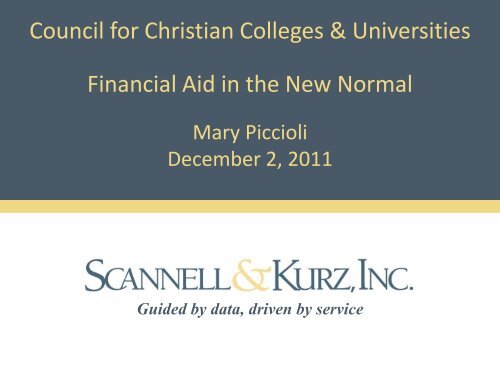

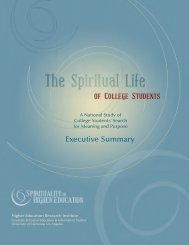
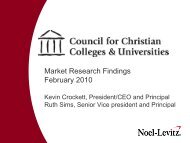


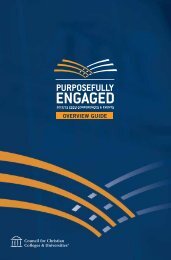

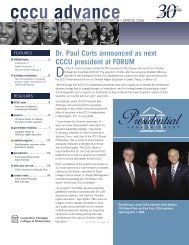
![Download Guide [PDF] - Council for Christian Colleges & Universities](https://img.yumpu.com/37211849/1/190x245/download-guide-pdf-council-for-christian-colleges-universities.jpg?quality=85)
